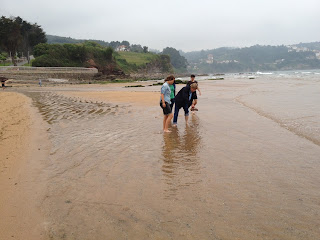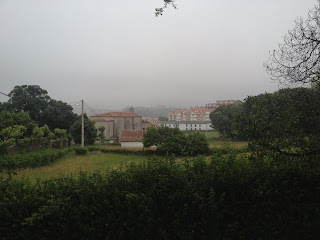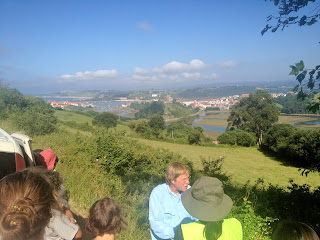most of the geological and historical stops and activities from the trip:
It was hard narrowing it down to just 250 pictures! I took nearly 3000 photos between my iPhones and camera during the trip. It is a very beautiful country and we saw and did a lot of interesting things -- and this was a very photogenic group -- so I'll be posting an additional collection in the future for the trip participants interested in more great pictures of the geology, history, and themselves than we could fit into this first slideshow.
We are also planning on putting together a "best of" collection, once more people have a chance to share their photos from the trip. I'm looking forward to seeing some of the pictures taken of myself for one.
12 July 2012
30 June 2012
Back Where We Started
 |
| University of Michigan, Dept. of Earth and Environmental Sciences Spain 2012 Field Trip group near Potes, Spain, looking northwestward with the Picos de Europa in the background. |
It's been an amazing trip this year, with a great, enthusiastic group of students. We saw a lot of fantastic rocks over the last two weeks, and sampled some interesting food and culture as well. A big thanks again to Maribel for all her efforts, and to those who helped subsidize the cost of the trip and ensure important opportunities like this remain within the reach of our students.
My apologies for all the typos and mistakes in posts during the trip; I never did get the hang of the accents on the iPhone's Spanish keyboard, the auto-correct turned geology terminology into some interesting alternatives, and we had a very packed schedule, so proof-reading was not an option; no blogging while driving!
Keep your eyes on this space for posts of some of the fantastic photos we took during the trip...
Queue #8, #9, #10
We've arrived in Detroit. Next up the queues for passport control,
luggage, and customs. Then outside for the U-M bus, which
hopefully will be waiting for us curbside.
luggage, and customs. Then outside for the U-M bus, which
hopefully will be waiting for us curbside.
Onboard
Somewhere up there is the front of the plane. We are not near it. All
set for an on-time departure though. Look for the map to show us in
Detroit in 8-1/2 hours or so...
set for an on-time departure though. Look for the map to show us in
Detroit in 8-1/2 hours or so...
Queue #6
Through secondary security to the gate's boarding area for our flight
to Detroit. Everyone accounted for and on schedule so far. Plane is at
gate behind us.
to Detroit. Everyone accounted for and on schedule so far. Plane is at
gate behind us.
Amsterdam
Completed the Amsterdam leg of our return trip. Arrived about 15
minutes late, however, we have a long layover here, so no mad dash
across the airport this time. Our Detroit flight is currently
scheduled for an on-time departure, so that gives us a few hours to
explore Schiphol before we take off at 5:10pm local time.
minutes late, however, we have a long layover here, so no mad dash
across the airport this time. Our Detroit flight is currently
scheduled for an on-time departure, so that gives us a few hours to
explore Schiphol before we take off at 5:10pm local time.
Queue #1
So far so good. Checked out of hotel. Rental cars returned. Still have
everything and everyone. Now the first of many queues today, the KLM
check-in counter...
everything and everyone. Now the first of many queues today, the KLM
check-in counter...
29 June 2012
Nearly Done...
After 8 hours of driving, with a stop to see Roman gold mines, now the
cars are parked and hotel rooms checked into... time to relax outside
of Cervantes House.
cars are parked and hotel rooms checked into... time to relax outside
of Cervantes House.
Alcala de Henares
Our last major stop is Alcala de Henares. We've walked down to the old
city center to explore. Tomorrow we have to return the rentals and
catch our flight home.
city center to explore. Tomorrow we have to return the rentals and
catch our flight home.
Las Medulas
Las Medulas is an area of Roman-era gold mining. They worked these
placer deposits by re-routing water into the area to fill vertical
shafts and horizontal galleries they dug of varying widths, which
hydraulically collapsed the surrounding deposits and washed them into
a settling pond, where the gold could more easily be separated.
placer deposits by re-routing water into the area to fill vertical
shafts and horizontal galleries they dug of varying widths, which
hydraulically collapsed the surrounding deposits and washed them into
a settling pond, where the gold could more easily be separated.
28 June 2012
Sea Arches
There are many interesting erosional features that can only be
accessed at low tide along Cathedral Beach. Here are a couple of the
sea arches in Upper Cambrian shelf sands.
accessed at low tide along Cathedral Beach. Here are a couple of the
sea arches in Upper Cambrian shelf sands.
Cathedral Beach
The tide needs to go out some before can get to some of the sites
here, so well just have to go for a swim first...
here, so well just have to go for a swim first...
Water Wheels
In Mazonovo, near Terrimundi, we stopped to look at old water powered
mills. In addition to grist mill operations, power generation was
carried out in the building on the left until just recently.
mills. In addition to grist mill operations, power generation was
carried out in the building on the left until just recently.
Protest Fires
The tires are alight... Hopefully that means things will be coming to
an end soon, but we don't know... We're probably about a mile back
from the protest.
an end soon, but we don't know... We're probably about a mile back
from the protest.
Road Block
We are taking on unplanned break to experience civil protest. The coal
miners in northern Spain have been protesting the government's
decision to cut their subsidies by blocking major roads. Yesterday we
saw some of the circular scorches from previous tire burnings on the
roads near Villamanin. Today we're stuck along the A-8 near Soto.
Unfortunately we cannot simply turn around, as we are boxed in by
cliffs and gaurdrails on the median, so we will likely be here for
awhile...
miners in northern Spain have been protesting the government's
decision to cut their subsidies by blocking major roads. Yesterday we
saw some of the circular scorches from previous tire burnings on the
roads near Villamanin. Today we're stuck along the A-8 near Soto.
Unfortunately we cannot simply turn around, as we are boxed in by
cliffs and gaurdrails on the median, so we will likely be here for
awhile...
Spain Victorious!
Last night, after a typical wonderful day in the field, most of the
group watched Spain defeat Portugal on penalty, and learned a few
cheers from the locals.
group watched Spain defeat Portugal on penalty, and learned a few
cheers from the locals.
27 June 2012
Manganese Nodules and Phosphate Crusts
In the Lower Carboniferous age section here we see a potential buried manganese-phosphate
crust layer. Sedimentation rates see definitely low in this section.
Unfortunately it is behind a Prohibito sign and we had to leave before
we had time for a thorough look.
crust layer. Sedimentation rates see definitely low in this section.
Unfortunately it is behind a Prohibito sign and we had to leave before
we had time for a thorough look.
Biota
Lots of plants and bones in this conglomerete. Pictured is a small bone, potentially an amphibian or early reptiles scapula?
Big Calcite Crystals
We find massive calcite crystals in fractures throughout this part of
the Devonian section. These calcites are cloudy, so they most likely
formed in higher temperatures; lots of two-phase fluid inclusions
here.
the Devonian section. These calcites are cloudy, so they most likely
formed in higher temperatures; lots of two-phase fluid inclusions
here.
Favosites
Fabric indies coral in growth position. A lot of them here, as well as
other indicators, so beds are overturned.
other indicators, so beds are overturned.
Upsection or Downsection?
We're hiking up and the beds are steeply dipping, and we end up in a
Dolomite. Overturned? What should be next?
Dolomite. Overturned? What should be next?
Lancara
Our first close up look at one of the red sandstones, the Lancara. We
see a lot of brachipods and echinoderms here.
see a lot of brachipods and echinoderms here.
Sheep Dogs
Lots of flocks of sheep are left to wander around this wonderful
geology unattended, but for a few dogs to watch after each group.
geology unattended, but for a few dogs to watch after each group.
Day 10
Overview of the Cambrian thru Carboniferous in this area, and
comparison to similar rocks we have seen elsewhere. For instance, the
three reddish beds one can use as markers throughout most of the area;
Lancra, San Pedro (equivalent to the Old Red Sandstone), and Riot.
Also, when we see gorse -- in bloom with yellow flowers at this time
of year -- we are looking at the sandstones.
comparison to similar rocks we have seen elsewhere. For instance, the
three reddish beds one can use as markers throughout most of the area;
Lancra, San Pedro (equivalent to the Old Red Sandstone), and Riot.
Also, when we see gorse -- in bloom with yellow flowers at this time
of year -- we are looking at the sandstones.
26 June 2012
Ezequiel Overview
Stop for an overview of the area we will be in today and tomorrow
around Villamamin. Grey turbidites of Carboniferous age are behind us
in the picture.
around Villamamin. Grey turbidites of Carboniferous age are behind us
in the picture.
Beach Proccesses
A chance to see tidal influence in action as the tide goes out, we can
see the ripples migrating in this channel.
see the ripples migrating in this channel.
Paleopedologists
Jen and Tim point to root traces in a great paleosol section we've
found near the previous dinosaur tracks. They are standing on a layer
containing carbonate nodules.
found near the previous dinosaur tracks. They are standing on a layer
containing carbonate nodules.
Sauropod Tracks
For those not immediately tempted by the sea, we've taken a short hike
to view more dinosaur tracks. The most prominent in this view are the
oval shaped tracks of sauropods.
to view more dinosaur tracks. The most prominent in this view are the
oval shaped tracks of sauropods.
Swim Call
While the locals probably think we are a bit crazy, years of swimming
in the Great Lakes has toughened up enough of our crew to take the
plunge in the Atlantic on this foggy, chilly morning. Hopefully the
fog will break in a couple hours. For now we have the beach to
ourselves!
in the Great Lakes has toughened up enough of our crew to take the
plunge in the Atlantic on this foggy, chilly morning. Hopefully the
fog will break in a couple hours. For now we have the beach to
ourselves!
Day 9
Today is our day for beach processes! Unfortunately the weather isn't
cooperating. Compare this mornings view in San Vicente with
yesterday's.
cooperating. Compare this mornings view in San Vicente with
yesterday's.
25 June 2012
Samples
As a pre-dinner snack, we visted downtown San Vicente to sample
chipirones, rabas, navajas, anchos, boquerones en vinagre, and chorizo
a la sidra.
chipirones, rabas, navajas, anchos, boquerones en vinagre, and chorizo
a la sidra.
Tidal Systems
The modern tidal system in San Vicente. The tide range here is about
10-feet, and is just starting to come in. The tidal flats on the right represent an environment we have seen a number of times now on the rock record.
10-feet, and is just starting to come in. The tidal flats on the right represent an environment we have seen a number of times now on the rock record.
Subscribe to:
Posts (Atom)
















































